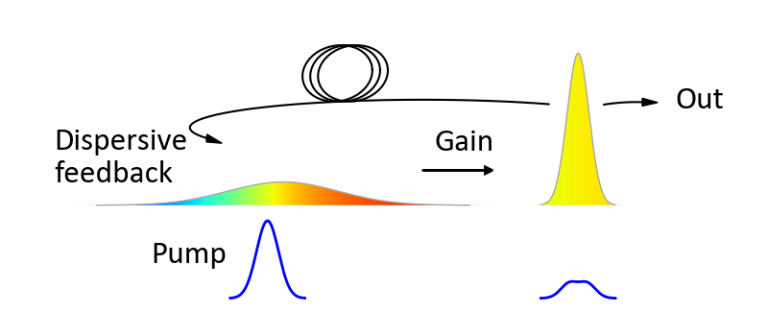Technology
Our frequency converters are based on fiber-feedback technology and combine an intra-cavity passive optical fiber with a bulk nonlinear medium that provides optical gain.

The intra-cavity single-mode fiber does not only result in a compact footprint but provides you with continuous mode-cleaning for great beam quality, and most importantly stabilizes the temporal dynamics of the oscillator by dispersive feedback. Depending on wavelength this makes our systems 20 – 100x less sensitive to ambient conditions as compared to conventional OPO or OPA systems.
This allows us to operate the system in a purely passive fashion, rendering piezo control and feedback loops for wavelength stabilization obsolete and enables an unprecedented reproducibility.
The flexible design supports femto- and picosecond solid-state and fiber lasers for pumping.
Check out our FAQ below as well or contact us if you have any questions.
FAQ
What makes the Alpha so stable?
We use a hybrid concept of fiber-feedback and parametric gain in a bulk nonlinear crystal. The intra-cavity fiber acts as a mode-cleaner and pins the pointing.
How does it tune so precisely?
We use dispersive stretching of our feedback pulse. By adjusting the timing between pump and feedback pulse we can tune continuous and gap-free with < 0.05 nm accuracy.
Why is it ultra low-noise despite the fiber?
The fiber is purely passive and does not emit amplified spontaneous emission (ASE) or other spurious signals. The Alpha reproduces the relative intensity noise of its pump laser and does easily reach <-160 dBc/Hz. We measured a temporal pulse contrast below 130 dB (M. Floess et al., Opt. Express 30(1), 1 (2022)).
How do I control your systems?
The system is fully automated and provides a websocket interface (ethernet or WiFi connection) to the user that can be accessed with any common programming language. The included GUI is written in C++, but comes with templates in python and LabVIEW. Simultaneous access from multiple clients is possible (e.g. watching the laser with the Stuttgart Instruments GUI and triggering wavelength steps by a python routine).
What is the difference to a classic OPO optical parametric oscillator?
The systems are based on a special type of OPO (so called, fiber-feedback OPO, FFOPO). This leads to an ultra-compact and completely passively stable combination which is characterized by outstanding low noise and passive long-term stability.
Wir benötigen Ihre Zustimmung zum Laden der Übersetzungen
Wir nutzen einen Drittanbieter-Service, um den Inhalt der Website zu übersetzen, der möglicherweise Daten über Ihre Aktivitäten sammelt. Bitte überprüfen Sie die Details in der Datenschutzerklärung und akzeptieren Sie den Dienst, um die Übersetzungen zu sehen.

